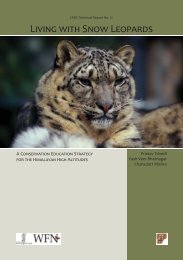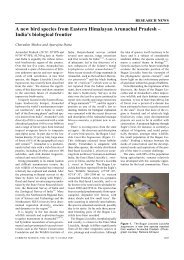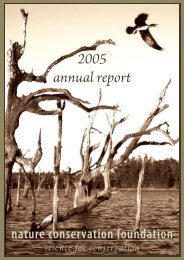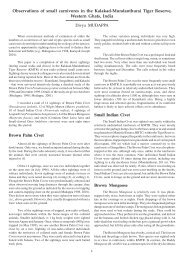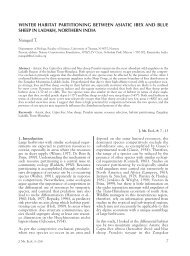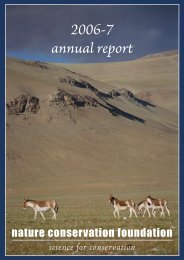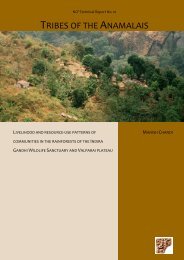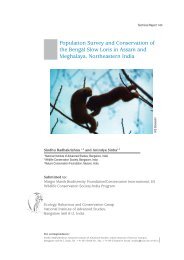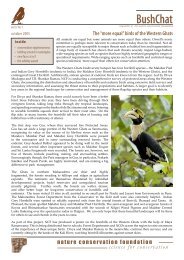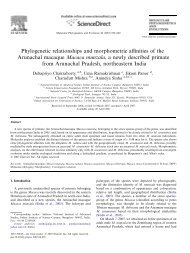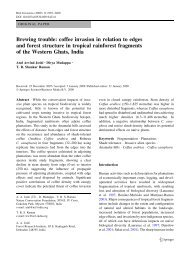towards project snow leopard - Nature Conservation Foundation
towards project snow leopard - Nature Conservation Foundation
towards project snow leopard - Nature Conservation Foundation
Create successful ePaper yourself
Turn your PDF publications into a flip-book with our unique Google optimized e-Paper software.
58 • Appendix 1<br />
and often circuitous route when it is too late for any activity. There are too many<br />
procedural bottlenecks and stringent and lengthy financial guidelines.<br />
2.2.5. Lack of funds for research-based activities: The Department is best placed to undertake<br />
long-term monitoring and research activities relating to conservation. This needs a<br />
relatively small, but continued allocation so that within the department, the activities<br />
are sustained.<br />
2.3. Infrastructure<br />
One way to suitably mitigate the problems of remoteness and a harsh climate is to have<br />
staff that is well equipped with good infrastructure to perform. The facilities that are largely<br />
lacking are:<br />
2.3.1. Lack of communication infrastructure: connected through mobile phones, and wireless<br />
sets.<br />
2.3.2. Lack of mobility: in terms of pack animals with no facility for hiring them.<br />
2.3.3. Lack of good camping equipment, clothes, boots, sleeping bags, and haversacks.<br />
2.3.4. Lack of staff quarters and guest houses with passive solar insulation for high altitudes.<br />
2.3.5. Lack of binoculars, GPS, ADIGital cameras, video cameras, maps, topo-sheets.<br />
2.4. Ecological and Information Constraints<br />
2.4.1. Lack of coordination and information sharing with research agencies: The area is rich in<br />
terms of its biological resources. There are some Government and Non-Governmental<br />
agencies that have been working in the state, but mostly without any coordination.<br />
Further the relevant information is not shared with the state forest department.<br />
2.4.2. Lack of carrying capacity studies (pastoralism, tourism): For regulating both grazing<br />
pressures and tourism activities, it is important to have some figures for permissible<br />
limits of entry/use. This information needs to be generated using the best accepted<br />
techniques in order to guide conservation in the state.<br />
2.4.3. Lack of information on wildlife ecology: There is little or no information on the ecology<br />
of most wild animals of the region, including on endangered species.<br />
2.4.4. Lack of wildlife intelligence, poaching, trade, trapping, wildlife casualties, and<br />
persecution: With the lack of this information, it becomes very difficult for taking<br />
suitable corrective steps to curb illegal activities.<br />
2.4.5. Lack of Wildlife population monitoring: Information on distribution and status of<br />
species is mostly lacking for most of the area.<br />
2.4.6. Lack of socio-economic and demographic profile: Demographic and socio-economic<br />
information helps in taking many management decisions. Some such information,



